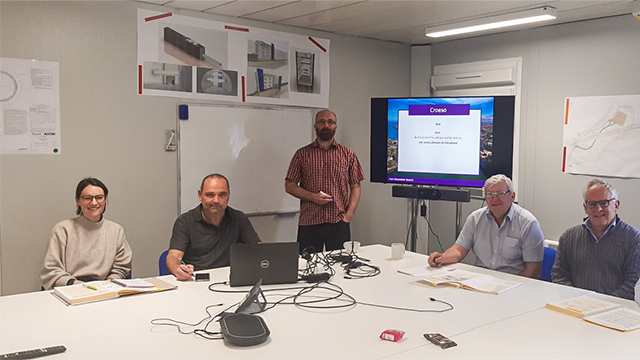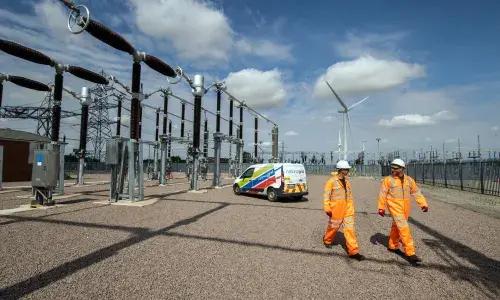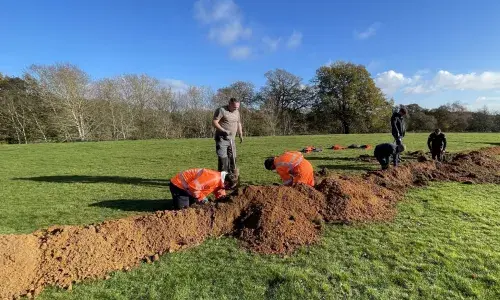
Eryri VIP team working in partnership with Bangor University to learn Welsh
- Eryri VIP team members from National Grid and its appointed contractor, Hochtief UK, have been learning Welsh through the Learn Welsh centre.
- Lessons are arranged through Learn Welsh North West based at Bangor University.
- The scheme is funded through the Welsh Government to support businesses that promote the Welsh Language.
National Grid’s Eryri VIP (Visual Impact Provision) project is demonstrating its commitment to the local community and culture in North Wales by encouraging those working on the project to learn Welsh.
Staff from National Grid as well as from Hochtief UK, the appointed contractor on the Eryri VIP project, started Welsh language lessons in September 2022. 11 employees are currently taking the classes, adding to the seven members of the team who are already fluent Welsh speakers, many of whom live locally.
Arranged through Learn Welsh North West (Dysgu Cymraeg Gogledd-Orllewin) based at Bangor University, the lessons are free of charge and are funded through the Welsh Government, which runs the scheme to support businesses to promote the Welsh Language.
Learn Welsh North West provides Welsh language courses at all levels in Gwynedd, Conwy and Anglesey on behalf of the National Welsh Learning Centre, which is responsible for all aspects of the Learning Welsh sector – from the curriculum and resources for tutors, to research, marketing, communication and e-learning.
Dr Ifor Gruffydd, Director, Learn Welsh North West, said: “National Grid and Hochtief UK are two great examples of firms truly demonstrating their commitment to respecting the social and cultural fabric of the areas in which they work.
“Thanks to funding from Welsh Government, our officers are able to work with the private sector to offer tailored, focused support to enable staff to learn Welsh in their own environment, at their own pace.
“The Eryri VIP team has been learning since September and has already made amazing progress. The learners tell us that they able to converse with increasing confidence as they work and socialise in the community.”
Respecting the local culture wherever we work is one of our core values and making Welsh classes available to our project team is an important part of that.
Steve Ellison, National Grid Senior Project Manager for Eryri VIP, said: “The Visual Impact Provision project in Eryri National Park aims to reduce the visual impact of National Grid’s overhead line across the Dwyryd Estuary.
“Stakeholders have been at the heart of the project throughout and the scheme has been designed and refined with the advice of local experts and community representatives.
“Respecting the local culture wherever we work is one of our core values and making Welsh classes available to our project team is an important part of that. We’re grateful to Learn Welsh North West, who have been extremely supportive and have made the classes practical, approachable and a lot of fun for our team.”
Find out more information about the Eryri VIP project.
Contact for media information:
[email protected]
Notes to Editors
About Visual Impact Provision
All electricity transmission owners are funded by a price control mechanism which is agreed with and set by Ofgem, the electricity and gas markets regulator. Ofgem has agreed a set of price controls and incentives for the period from April 2021 to March 2026, following the previous period (2013-2021). The new price controls and incentives include a provision of £465 million to mitigate the visual impact of existing electricity infrastructure in nationally protected landscapes in Great Britain.
For National Grid, the electricity transmission owner in England and Wales, this means considering the visual amenity of our existing infrastructure in Areas of Outstanding Natural Beauty (AONBs) and National Parks.
The Visual Impact Provision project has advised throughout by an independent panel of senior landscape experts from leading environmental organisations including the National Trust, the Ramblers, the Landscape Institute and the Campaign for National Parks plus CPRW, Natural Resources Wales, Cadw and their English counterparts. The Group is chaired by environmentalist and broadcaster, Chris Baines.
The Eryri VIP project is one of only five in England and Wales alongside others granted planning consent in the Dorset AONB and Peak District National Park which are nearing completion, as well as the North Wessex Downs AONB which submitted its planning application in February this year, and a potential project in the Cotswolds AONB which is now in the early stages of planning.
National Grid in the UK
National Grid sits at the heart of Britain’s energy system. The individual companies in our group run the systems and infrastructure that connect millions of people to the electricity they use every day.
Our regulated businesses own and develop the high voltage electricity transmission (ET) network in England and Wales, and the electricity distribution (ED) network in the Midlands, South West England and South Wales. Operating separately from these core regulated units, National Grid Ventures (NGV) focusses on competitive markets, investing in energy projects, technologies and partnerships such as electricity interconnectors.
We bring energy to life, with an ambition to serve our customers well, support the communities in which we operate, and make possible a clean, affordable and resilient energy network of the future.
Facts about our networks in England and Wales
- Our transmission network takes electricity generated from different power sources and carries it at high voltage via our 4,500 miles of overhead line, 1,500 miles of underground cable and 350 substations.
- Our distribution network delivers electricity at lower voltage from our transmission network to where it’s needed in the regions we serve, via 60,000 miles of overhead line and 83,900 miles of underground cable.
Find out more on our website about the difference between our networks.


